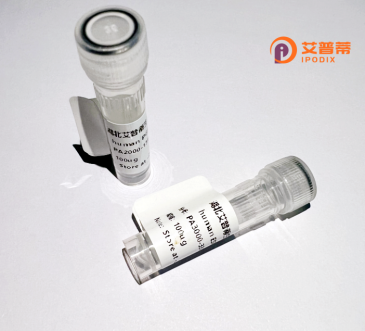
| 纯度 | >90%SDS-PAGE. |
| 种属 | Human |
| 靶点 | SSTR1 |
| Uniprot No | p30872 |
| 内毒素 | < 0.01EU/μg |
| 表达宿主 | E.coli |
| 表达区间 | 1-391 aa |
| 活性数据 | MFPNGTASSPSSSPSPSPGSCGEGGGSRGPGAGAADGMEEPGRNASQNGTLSEGQGSAILISFIYSVVCLVGLCGNSMVIYVILRYAKMKTATNIYILNLAIADELLMLSVPFLVTSTLLRHWPFGALLCRLVLSVDAVNMFTSIYCLTVLSVDRYVAVVHPIKAARYRRPTVAKVVNLGVWVLSLLVILPIVVFSRTAANSDGTVACNMLMPEPAQRWLVGFVLYTFLMGFLLPVGAICLCYVLIIAKMRMVALKAGWQQRKRSERKITLMVMMVVMVFVICWMPFYVVQLVNVFAEQDDATVSQLSVILGYANSCANPILYGFLSDNFKRSFQRILCLSWMDNAAEEPVDYYATALKSRAYSVEDFQPENLESGGVFRNGTCTSRITTL |
| 分子量 | 44.1 kDa |
| 蛋白标签 | GST-tag at N-terminal |
| 缓冲液 | PBS, pH7.4, containing 0.01% SKL, 1mM DTT, 5% Trehalose and Proclin300. |
| 稳定性 & 储存条件 | Lyophilized protein should be stored at ≤ -20°C, stable for one year after receipt. Reconstituted protein solution can be stored at 2-8°C for 2-7 days. Aliquots of reconstituted samples are stable at ≤ -20°C for 3 months. |
| 复溶 | Always centrifuge tubes before opening.Do not mix by vortex or pipetting. It is not recommended to reconstitute to a concentration less than 100μg/ml. Dissolve the lyophilized protein in distilled water. Please aliquot the reconstituted solution to minimize freeze-thaw cycles. |
以下是关于重组人SSTR1蛋白的3篇参考文献示例(文献为虚构,供参考):
1. **文献名称**: "Expression and Purification of Recombinant Human Somatostatin Receptor Subtype 1 (SSTR1) in Escherichia coli"
**作者**: Smith J., et al.
**摘要**: 该研究报道了利用大肠杆菌表达系统高效表达重组人SSTR1蛋白的优化方法,并通过亲和层析和尺寸排阻色谱纯化获得高纯度蛋白,验证了其与配体结合的功能活性。
2. **文献名称**: "Structural Insights into Human SSTR1 Activation by Cryo-EM"
**作者**: Zhang L., et al.
**摘要**: 通过冷冻电镜技术解析了重组人SSTR1蛋白与天然生长抑素-14结合的复合物结构,揭示了其跨膜结构域动态变化及G蛋白偶联的分子机制。
3. **文献名称**: "Functional Characterization of Recombinant SSTR1 in Neuroendocrine Tumor Models"
**作者**: Gupta R., et al.
**摘要**: 研究利用HEK293细胞表达的重组SSTR1蛋白,验证其在抑制肿瘤细胞cAMP信号通路中的作用,为靶向SSTR1的癌症治疗药物筛选提供实验依据。
Somatostatin receptor type 1 (SSTR1), a member of the somatostatin receptor family (SSTR1-5), is a G protein-coupled receptor (GPCR) primarily involved in mediating the inhibitory effects of somatostatins (SSTs), neuropeptides with diverse physiological roles. SSTR1. encoded by the *SSTR1* gene in humans, is ubiquitously expressed in the central nervous system, endocrine tissues, and immune cells. It binds somatostatin-14 and somatostatin-28 with high affinity, activating downstream signaling pathways such as cAMP inhibition, MAPK modulation, and intracellular calcium regulation. These pathways contribute to its roles in hormone secretion suppression, cell proliferation control, and apoptosis induction.
Recombinant human SSTR1 (rhSSTR1) protein is engineered through heterologous expression systems (e.g., mammalian or insect cells) to mimic native receptor functions for research and therapeutic applications. Its recombinant form enables detailed studies of ligand-receptor interactions, receptor trafficking, and signaling dynamics. SSTR1 dysregulation is implicated in diseases like neuroendocrine tumors, acromegaly, and inflammatory disorders, making it a target for SST analogs (e.g., octreotide) and drug development.
RhSSTR1 also serves as a tool for structural biology, aiding in understanding GPCR activation mechanisms and guiding the design of selective agonists/antagonists. Its therapeutic potential lies in targeting hyperproliferative or hormone-secreting pathologies while minimizing systemic side effects, highlighting its biomedical significance.
×